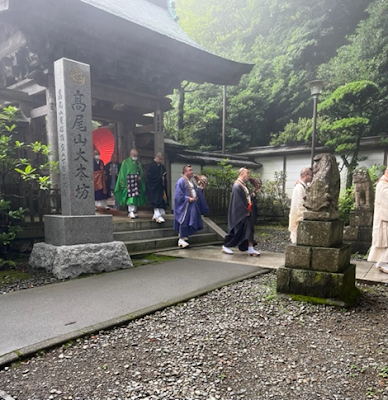It was drizzling in the morning and was a little cooler after the heavy rain caused by Typhoon No. 13 while the moisture in the air prevented us from enjoying a clear view from Mt. Takao.
After the six (6) minute cable car ride, we found that everything was enveloped in a fog or mist. By that time, we had already decided to give up the idea of going up to the peak of the mountain.
After guiding our guests on Monkey Park, Octopus Cedar Tree, Flora of Mt. Takao (including its rich biodiversity thanks to the geographical location, geological features, etc.) and Joshin-mon Gate, it’s almost lunch time.
Then, we moved on to the peak of Jimben-yama (Jimben
Hill), a little elevated place between Trail No. 1 and Trail No. 4 where there
is a newly established memorial monument for forestry martyrs.
Actually, he had already finished his rice ball lunch
assuming a piece of black paper is a part of wrapping materials. As he was fully aware of our “Don’t leave any
garbage behind” campaign at Mt. Takao, he still kept a piece of black paper as
a part of the garbage he should bring back to the JICA Dormitory. Then, understanding that a piece of black
paper is a part of his lunch, he started eating it with a nice smile! I was happy to see that!
After spending some twenty (20) minutes there, around
1:10 pm we moved back to Trail No. 1 around the Jimben-do which is dedicated to
En-no Gyoja, the founder of Shugendo for some guiding there.
At the fork in Trail No. 1, I tried to convince our guests to take an easy route nicknamed “women’s slope”, saying that they appeared to be free from the 108 worldly desires.
Unfortunately, our guests were full of energy (and full of worldly desires?) and were willing to follow the more challenging route nicknamed “men’s slope” involving the 108 stone steps to eliminate their 108 worldly desires.
Then, we moved forward on Trail No. 1 guiding on the list of contributors, huge old cedar trees, Shitenno-mon (the Gate of Four Heavenly Kings), etc. on the way to the grounds of Yakuo-in Temple.
Guiding and spending some time in the grounds of
Yakuo-in Temple, in front of the living quarters of monks, we were able to
witness the procession of Buddhist monks on the way to their 5th performance of
Buddhist fire ritual called “Goma Fire Ritual” starting at 2:00 pm at the main
hall of Yakuo-in Temple.
After looking at the procession of Buddhist monks and mountain priests, some of our guests asked us how Buddhist temples are financially supported, what is the population of Buddhist and Shintoist like, etc.
Then, for a change, we took a chair lift from the
Sanjo Station to the Kiyotaki Station, which might have been more exciting to our
guests.
We came back to the foot of the mountain around 3:45 p.m. and took a group photo with our guests again in front of the cable car station, which was the end of the tour.








0 件のコメント:
コメントを投稿